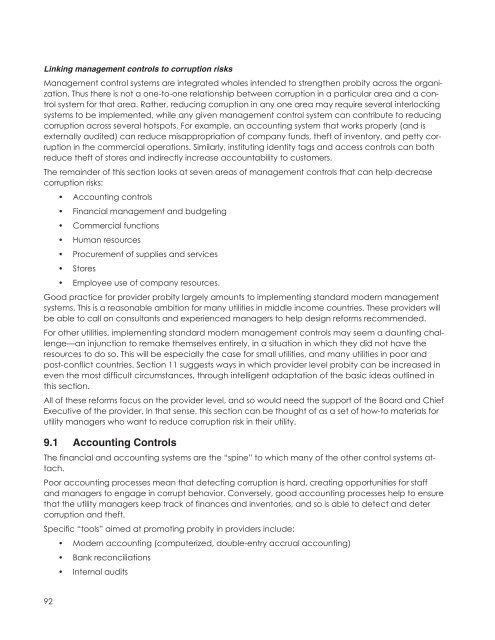A Sourcebook - UN-Water
A Sourcebook - UN-Water
A Sourcebook - UN-Water
Create successful ePaper yourself
Turn your PDF publications into a flip-book with our unique Google optimized e-Paper software.
Linking management controls to corruption risks<br />
Management control systems are integrated wholes intended to strengthen probity across the organization.<br />
Thus there is not a one-to-one relationship between corruption in a particular area and a control<br />
system for that area. Rather, reducing corruption in any one area may require several interlocking<br />
systems to be implemented, while any given management control system can contribute to reducing<br />
corruption across several hotspots. For example, an accounting system that works properly (and is<br />
externally audited) can reduce misappropriation of company funds, theft of inventory, and petty corruption<br />
in the commercial operations. Similarly, instituting identity tags and access controls can both<br />
reduce theft of stores and indirectly increase accountability to customers.<br />
The remainder of this section looks at seven areas of management controls that can help decrease<br />
corruption risks:<br />
• Accounting controls<br />
• Financial management and budgeting<br />
• Commercial functions<br />
• Human resources<br />
• Procurement of supplies and services<br />
• Stores<br />
• Employee use of company resources.<br />
Good practice for provider probity largely amounts to implementing standard modern management<br />
systems. This is a reasonable ambition for many utilities in middle income countries. These providers will<br />
be able to call on consultants and experienced managers to help design reforms recommended.<br />
For other utilities, implementing standard modern management controls may seem a daunting challenge—an<br />
injunction to remake themselves entirely, in a situation in which they did not have the<br />
resources to do so. This will be especially the case for small utilities, and many utilities in poor and<br />
post-conflict countries. Section 11 suggests ways in which provider level probity can be increased in<br />
even the most difficult circumstances, through intelligent adaptation of the basic ideas outlined in<br />
this section.<br />
All of these reforms focus on the provider level, and so would need the support of the Board and Chief<br />
Executive of the provider. In that sense, this section can be thought of as a set of how-to materials for<br />
utility managers who want to reduce corruption risk in their utility.<br />
9.1 Accounting Controls<br />
The financial and accounting systems are the “spine” to which many of the other control systems attach.<br />
Poor accounting processes mean that detecting corruption is hard, creating opportunities for staff<br />
and managers to engage in corrupt behavior. Conversely, good accounting processes help to ensure<br />
that the utility managers keep track of finances and inventories, and so is able to detect and deter<br />
corruption and theft.<br />
Specific “tools” aimed at promoting probity in providers include:<br />
• Modern accounting (computerized, double-entry accrual accounting)<br />
• Bank reconciliations<br />
• Internal audits<br />
92
















